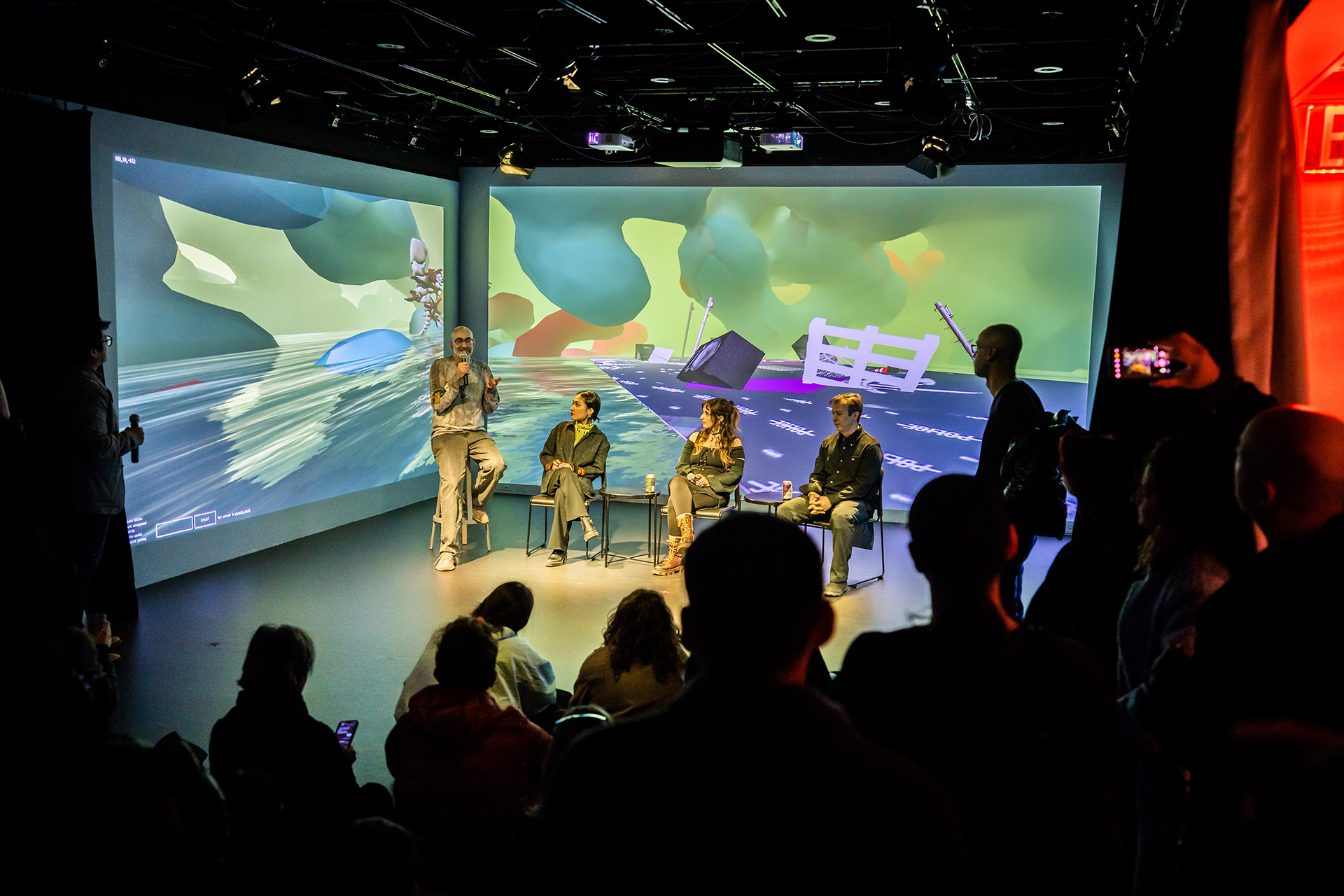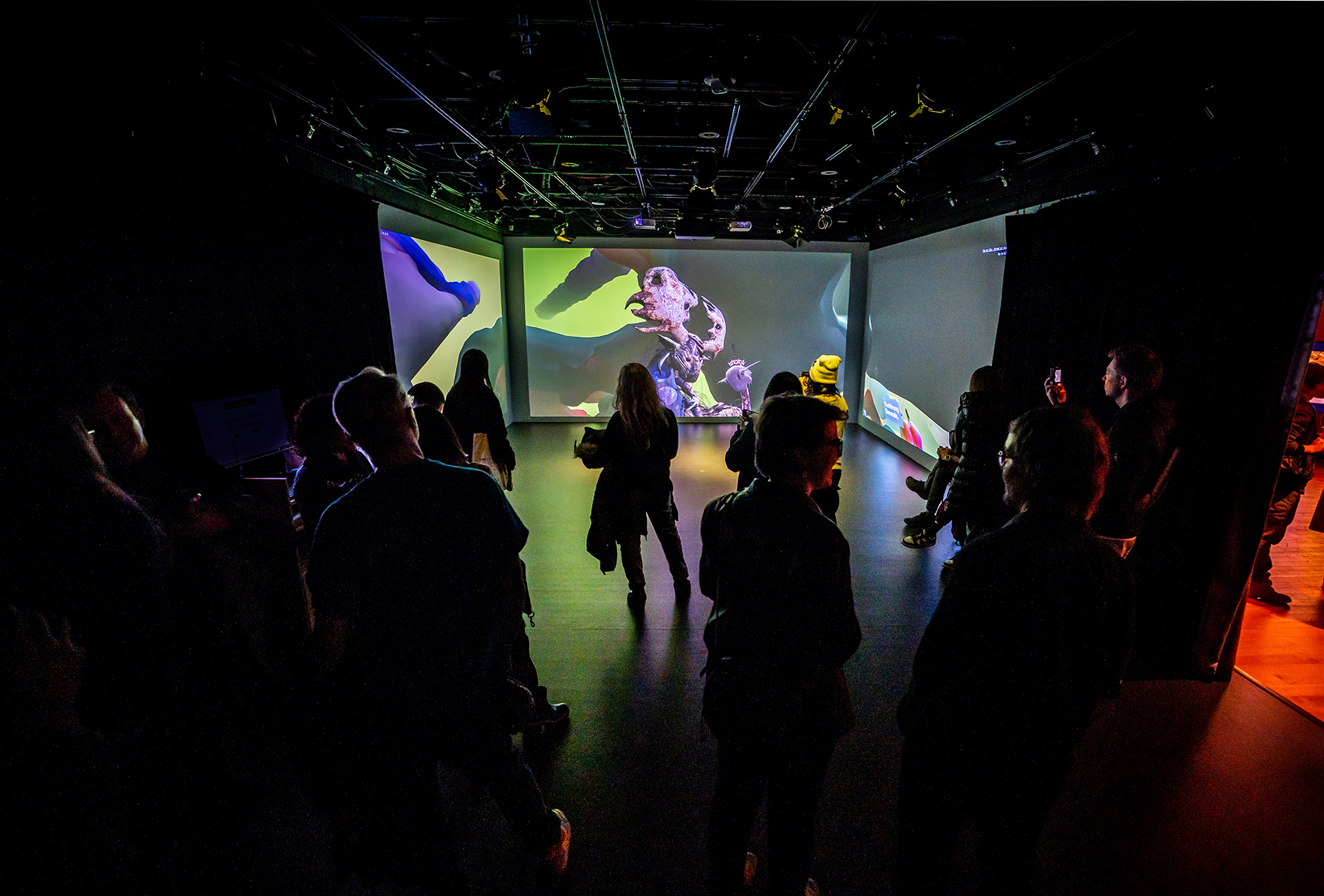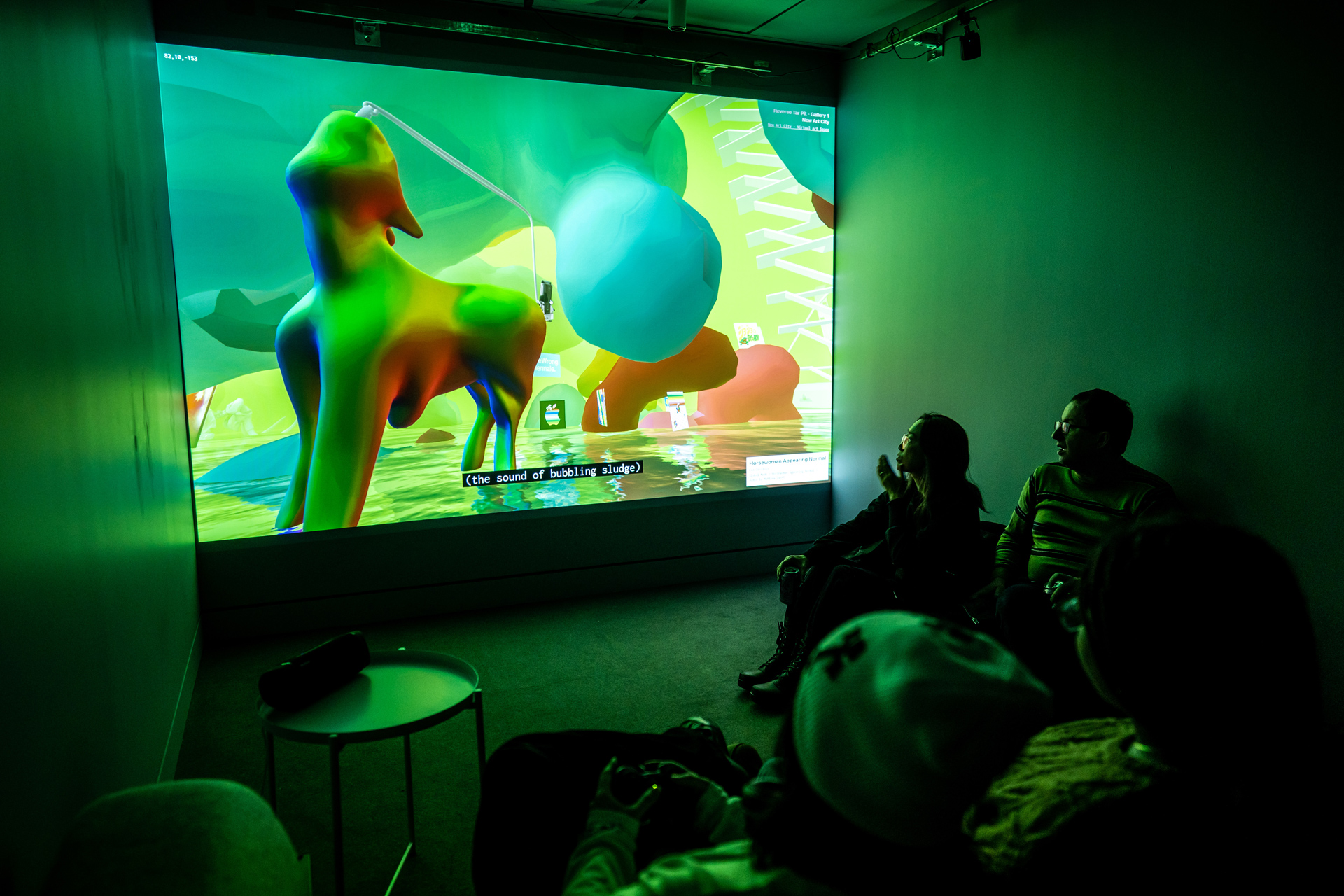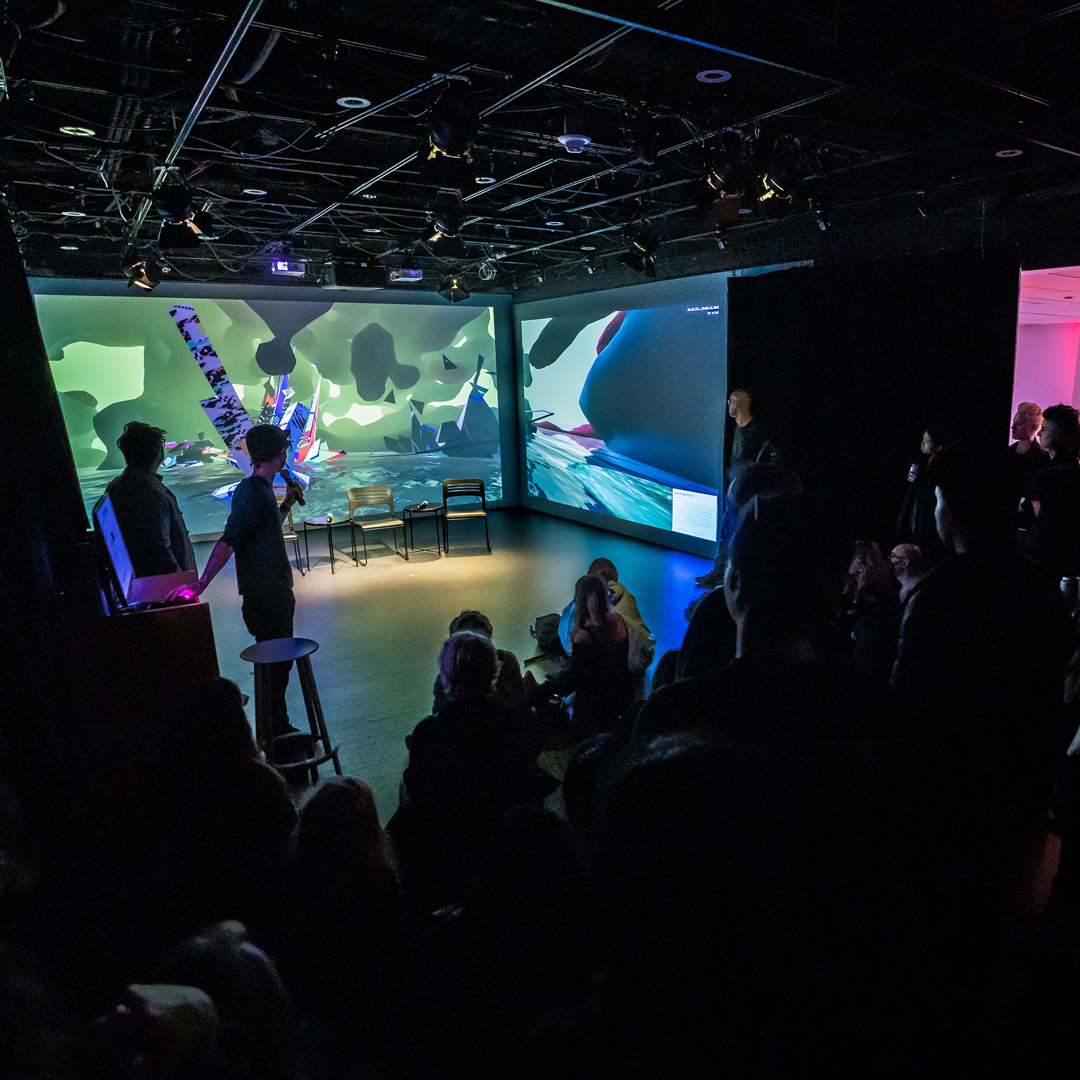In this Article 🗒️
- Introducing New Art City's hybrid exhibition research project
- A snapshot of "Reverse Tar Pit" a hybrid exhibition at Onassis ONX Studio in NYC
- Evaluating new and old strategies for exhibiting digital art in physical space
- Seeking organization collaborators for hybrid exhibitions that merge digital and physical art, focusing on experimental and accessible approaches. Email us!
When New Art City started, our goal was to create a better way of showing digital art online. Since then we’ve successfully created an online exhibition model that serves thousands of artists across all sections of the art world. We now see the increasing need to present work created online in physical spaces where we gather and build community, and are actively researching and testing new ideas for interacting with the digital world in physical spaces. This blog post presents what we have tested so far, focusing on our most recent event Reverse Tar Pit hosted at Onassis ONX Studio in NYC, aiming to capture a snapshot of the exhibition and detail the strategies we employ to present digital art in physical spaces.
For the context of this article hybrid means a mix of digital and physical exhibition strategies for artwork, with the aim of presenting digital work in physical space. We see this is the most interesting current problem in mixed environments, but acknowledge that advancements also need to be made in hybridizing other aspects of events including co-presence for virtual and physical participants.

Artists presenting their work, from left to right:
Lee Tusman, Rosalie Yu, Indira Ardolic, Jeremiah Teipen.
About Reverse Tar Pit
Reverse Tar Pit is a group show featuring 19 artists spread across four virtual spaces curated by Mark Ramos and Don Hanson. The show is New Art City’s official pavilion of The Wrong Biennial: an international festival representing the largest celebration of internet art on the planet. The show's in-person reception featured three ways of presenting the digital works (three-channel automatic fly-through, 1-channel gamepad installation, and looping videos), and included in person and remote artist talks, giving context to the works on display. Despite the cold November evening we were thrilled by full attendance, with all RSVPs sold out.
Curatorial Statement by Mark Ramos:
From a seething sludge of digital debris and depleted fossil fuels, the zombie corpses of unminted nft’s rise shedding oily droplets of virtual decay. The included works began as digital files forgotten in the labyrinths of obsolete servers and subjected to the high pressures of networked hypermodernity, and now rise to take their revenge against a world drowning in media disinformation. They are fossils of software fragments, glitch-processed video, mutated 3D polygons, and keening audio tracks. Their file names glow with curatorial themes of decay and transformation, preservation and decomposition. It’s art for an anthropocene acutely aware of the cyclical nature of its own consumption and mortality.
Participating Artists:
Indira Ardolic, Delta_Ark, Itziar Barrio, Christopher Clary, Eva Davidova, Varkito Garcia, Don Hanson, Benny Lichtner, Kristin Lucas, Joe McKay, Cezar Mocan, Patrick O'Shea, Mark Ramos, Sarah Rothberg, Kat Sung, Jeremiah Teipen, Lee Tusman, Sammie Veeler, Rosalie Yu

Early visitors viewing the fly-through tour. Artwork pictured is Grisel Laur - Steed of the Goblin Prince by Kat Sung
Hybrid Exhibition Strategies
Automatic Fly-through:
This approach was successfully debuted at Reverse Tar Pit as a non-interactive way to observe the work through a projected viewpoint that automatically moves between artworks in a pre-programmed tour. This was effective as a passive way of engaging with the work, providing a consistently dynamic experience while requiring no interaction or operator. This makes the experience accessible to most viewers regardless of their level of experience navigating virtual spaces, and showcases each work of art from a vantage point chosen by the exhibition designer. The tour authoring interface is in beta testing now and is expected to become a standard New Art City feature.
Gamepad Controller:
New Art City is designed to work with the standard web gamepad API, which means you can plug almost any video game controller into a computer and the NAC interface will switch automatically to gamepad mode. This interaction model has become a standard for our hybrid exhibitions as a low-cost way to present virtual spaces without any additional conversions or preparation. Most visitors already know how to use a video game controller in first person view which makes it very intuitive to pick up and play. The added benefit is that the keyboard and mouse can be hidden away, preventing visitors from accidentally (or intentionally) leaving the webpage.
Dispersing Media:
Recognizing the multimedia nature of New Art City exhibitions which often include audio and video, this strategy focuses on the individual presentation of these media types. Most exhibition spaces working with technology are equipped to play audio and video files using a combination of playback devices, screens, projectors, and speakers. Presenting these works as looping media works well as an enhancement to the other strategies, and allows an exhibition to expand or contract to the size of the space.

The side room was set up to use Gamepad navigation, and made into a comfy space with a couch and beanbag. Artwork pictured is Horsewoman Appearing Normal by Eva Davidova.
Computer Kiosk:
The computer kiosk approach is the classic model of “net art in the gallery” where a computer is presented with a keyboard and mouse, allowing visitors to interact with the digital content. This model is enhanced by our World Archive & Export tool, which packages up the virtual space as a local offline copy. These exports can be run like any other website with the added benefit of instantaneous loading and no need for an Internet connection. This is a foundational strategy, providing a straightforward and stable way to integrate a navigable virtual space into a physical exhibition space. We did not use this strategy at Reverse Tar Pit because we want to test more experimental approaches.
Virtual Reality:
In October 2023 we tested our first headset based exhibition at the Gray Area Festival in San Francisco, presenting a work titled “Touch” by artist Nat Decker. The artwork itself was a success conceptually and visually, but the visitor experience using the headset in an exhibition setting was challenging due to the nature of headsets as a solitary and isolating experience, and friction onboarding visitors. While support for WebXR is technically possible, it is still not yet well supported in current headsets and we do not recommend it as an exhibition mode.
Seeking Partnerships for Virtual Hybrid Exhibitions
In 2024 we are seeking collaborations at organizations interested in to merge digital and physical art spaces. We want to co-produce and co-curate experimental events that test new models for showing digital art. We are especially interested in researching and testing approaches that broadly improve accessibility of digital art.
We invite organizations anywhere in the world to partner with us to produce an event, especially those who already have access to an installation space. Our goal is to jointly develop exhibitions that not only display art but also contribute to the understanding of hybrid art forms while supporting the global community of digital artists. For those interested in collaboration, we encourage you to send us an email.
Photos in this article were taken by Dan Gorelick.

